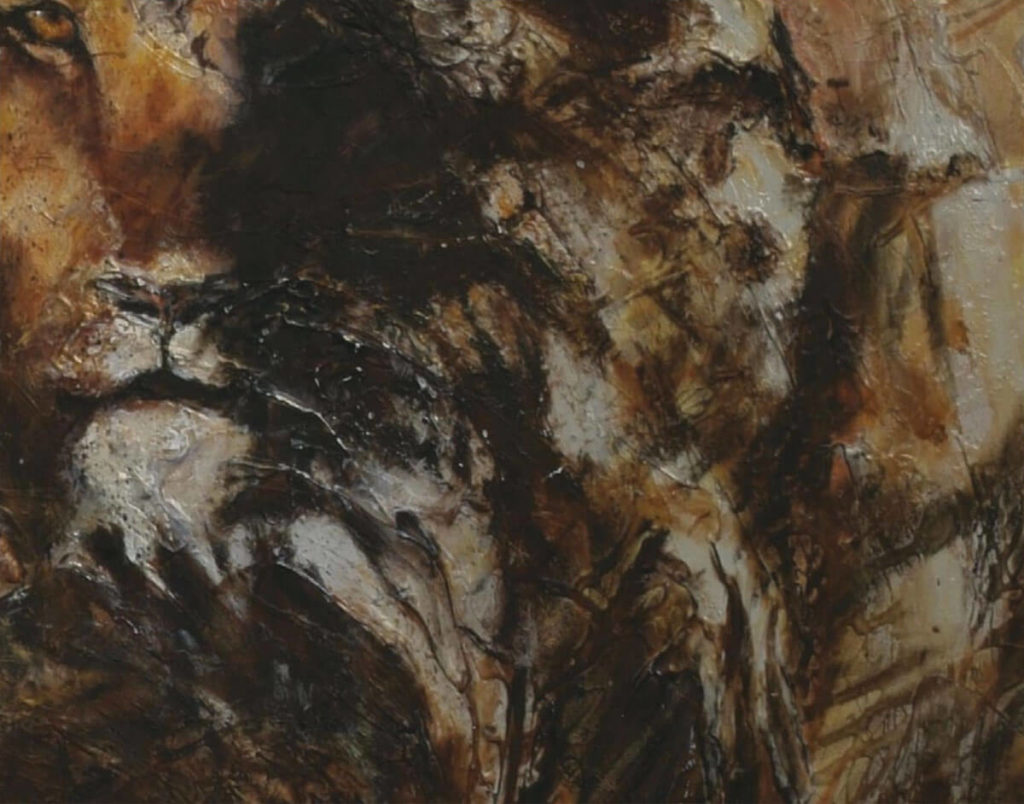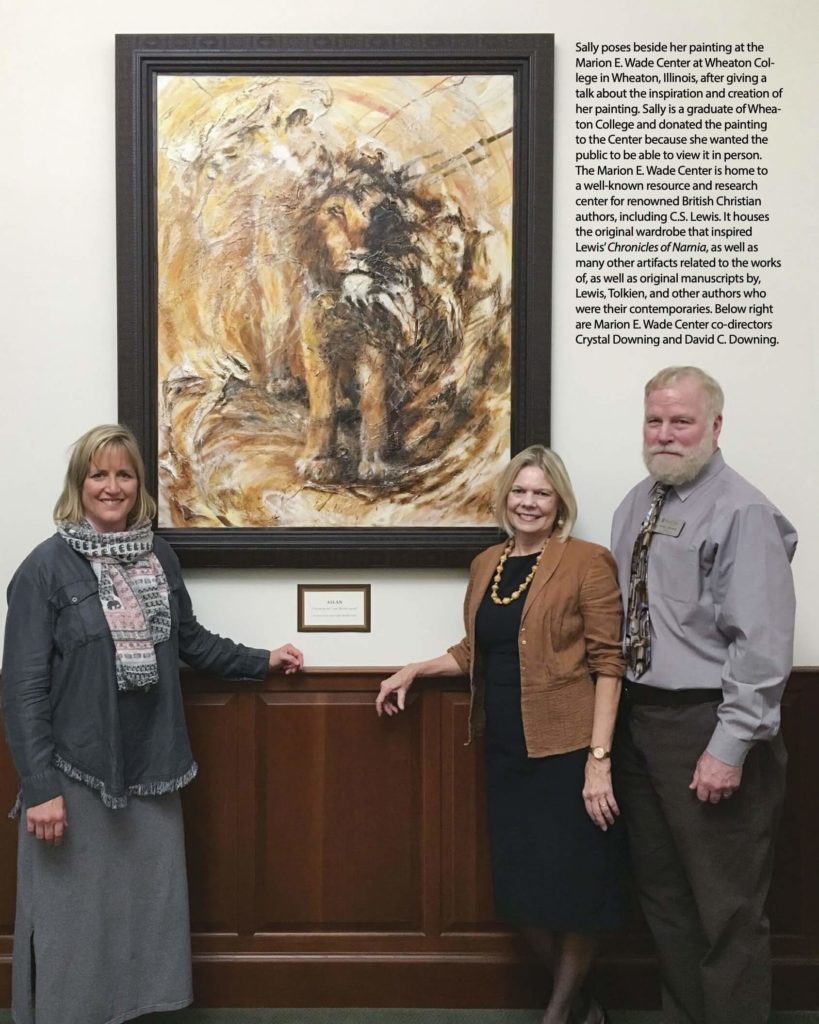Used by Permission from Today’s Christian Living (Issue Jan 2020)

Sally Brestin Hale’s 2003 acrylic painting “Aslan”— depicting the Christ-like lion in C.S. Lewis’ Narnia series —has been reproduced in prints and posters displayed in homes, churches, hospitals, prisons, retirement centers, and more, strengthening the faith of countless people around the world.
The amazing work reveals the mystery of God’s sovereignty. While Sally was working on the painting, an image of a sacrificial lamb appeared on the canvas without her awareness. It’s hard to comprehend how God accomplished this through her while fully preserving her personality, autonomy, and creativity, but through the account of the painting’s creation, we get a fascinating glimpse of His guiding hand at work.
The Great Paradox
The story behind “Aslan” begins with Sally’s struggle to understand how a good God can allow evil and suffering. “This is the universal question that man has asked since the beginning of time,” Sally said. Her inner conflict over the question was triggered by painful challenges in her life around 2000. Then the 2001 World Trade Center terrorist attack occurred, heightening her confusion and anxiety.
At the time, Sally was pursuing a master’s degree in Poland. As she wrestled with the question of evil and suffering, she visited Auschwitz and other sites connected to the Holocaust. She felt the anguish deeply and personally because her Jewish grandmother Brestin had escaped Poland as a teenager but was forced to leave behind family members who died at the hands of the brutal Nazi regime. Overwhelmed by these experiences, Sally returned to America to seek answers.
Not Safe, But Good
Back home, she immersed herself in her art, working in a room above her parents’ garage. Believing that the answers might come through painting Aslan, she decided to create a painting of him that combined both the holiness and love of God, attributes that, from our limited human perspective, can seem contradictory. As Mr. Beaver explains to Lucy in Lewis’s book The Lion, The Witch & The Wardrobe, Aslan isn’t safe. He is powerful and can’t be tamed. Yet he is also good.
“Is — Is he a man?” asked Lucy.
“Aslan a man!” said Mr. Beaver sternly. Certainly not. I tell you he is King of the wood and the son of the great Emperor beyond-the-Sea. Don’t you know who is the King of the Beasts? Aslan is a lion — the Lion, the great Lion.”
“Ooh!” said Susan, “I’d thought he was a man. Is he — quite safe? I shall feel rather nervous about meeting a lion.”
“That you will, dearie, and no mistake” said Mrs. Beaver; “if there’s anyone who can appear before Aslan without their knees knocking, they’re either braver than most or else just silly.”
“Then he isn’t safe?” said Lucy.
“Safe?” said Mr. Beaver; “don’t you hear what Mrs. Beaver tells you? Who said anything about safe? ’Course he isn’t safe. But he’s good. He’s the King, I tell you.”*

and Claire (7).

The Painting’s Impact
“Aslan” is a powerful work of art that has deeply affected viewers over the years. For instance, Dr. David Downing, co-director of the Marion E. Wade Center at Wheaton College, where the original painting is displayed, said he’s seen visitors moved to tears by it. Sally added that “a family told me after my talk at Wheaton that their house had been destroyed in a fire and they were living in a rental while it was rebuilt. A friend gave them a print of the painting, and the kids in the family kept it in their bedroom. The kids said that it helped them to feel safe because it reminded them that Aslan — Jesus — is watching over them.”
Reconciling the Great Paradox
Sally began a painting of Aslan, but wasn’t satisfied. “I really worked hard on it for two weeks but wasn’t getting it.” So she decided to start over with a larger painting. This time, she constructed the canvas herself because she needed one that was larger than local stores carried. She wanted Aslan to dominate the viewers as though he were stepping down out of the painting and they couldn’t escape him. That would convey the idea that he wasn’t safe. But she wasn’t sure how she could simultaneously evoke a sense of his goodness and love. The painting had to capture both his powerful, intimidating presence as well as his gentleness and compassion, a seemingly impossible task.
As she began the painting, she thought, If I’m too much in control, I’m not going to give God any room to work. I’m going to lay my canvas down and take textural modeling paste and throw it down, bringing about the structure of Aslan’s body from what just kind of happens spontaneously. That takes all the control off and He can do something with it. “I really wanted the painting to have a life of its own. The only way I could think of doing that was to throw the textural medium down,” she said.
She knew she would need the Lord to guide her through the process, so before painting each morning, she spent time in prayer, asking Him to guide her hand and speak to her through the painting.
Sally continued working on the painting, but as she made progress, she felt that while it was better than her first attempt, it still hadn’t accomplished her goal. “I got the part that he wasn’t safe, but I didn’t plainly see His goodness in the painting. I couldn’t get the paradox in. I couldn’t paint both at one time. It was frustrating. I just heard this still, small voice say, ‘This is a special painting, Sally. You need to get this one right.’”

The Lamb of God
Even after she finished, she thought it fell short of what she wanted to communicate. She could see the “not safe” aspect of Aslan, but not the “good” part. But when she displayed the painting at her church, a woman studying it said she could see another animal in it.
“She walked up and outlined it with her finger,” Sally said, referring to the image of a lamb in Aslan’s mane. “This wasn’t just a sort of ‘vision in the clouds’ type thing. This was the real deal. It kind of freaked me out. I stepped back and focused in on it and then I could really see it all. The legs together. It looked like it was bound, like in Revelation, where it says, “Behold the lion of the tribe of Judah… Then I saw a lamb that looked as though it had been slain” [Rev. 5:5–6]. It gave me chills up and down my spine.”
Finding Peace in Him
The Lord had guided Sally’s brush, palette knife, and paint to create the symbol of goodness and love that had eluded her for so long. Although the lamb didn’t answer her question about why God allows suffering, it confirmed to her that He loves us and is willing to suffer on our behalf to pay the penalty for our sins (1 John 4:10). And it comforted her to remember that He is a God who chose to enter our suffering, rather than staying outside and apart from it.
Divinely Guided
Sally thinks the lamb took shape near the end of the painting process. “I remember doing the highlights with the palette knife and the white,” she said. “And I was just finishing touches on the painting and it was very quick, really just scraping the highest surfaces of the painting with white. I don’t know exactly when it happened, but somewhere there in the finishing touches. He had to have guided my hand. It started at the beginning when I threw down all the textural medium in the first stage. At the very end of the painting, I scraped the white paint over the top of the medium without intending to create any particular shape, and that’s what created the outline of the lamb.”
Watch video interviews with Sally at https://deebrestin. com/aslan, where she shares more details about the story behind “Aslan.” Prints and posters of “Aslan” are also available to order on the site.
Sally Brestin Hale is the daughter of well-known Christian writer Dee Brestin and the late physician, Dr. Steve Brestin. Sally was named after Dee’s sister Sally, who led Dee to the Lord many years ago. Sally, her husband Phil, and their two daughters live in Albany, New York, where she works as a mental health counselor, often incorporating art therapy.
*From The Lion, the Witch & The Wardrobe by C.S. Lewis (HarperCollins Children’s Books, 1994).